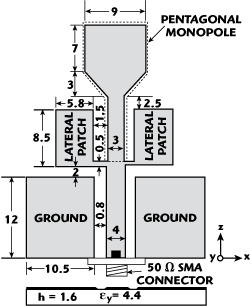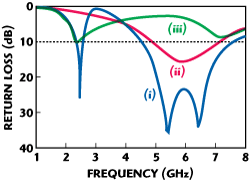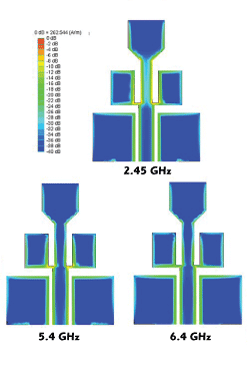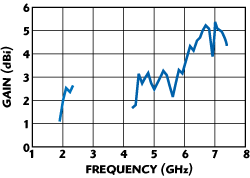Over the past decade, extensive research on broad dual- or multi-band antennas, with low-profile, lightweight, flush mounted and single-feed to fit the limited equipment space of portable wireless devices, has contributed to the development of modern communication technology. In the past, a whole host of dual- or multi-band planar antennas fed by either a microstrip line or a probe have been developed for various communication-related applications. These antenna designs include planar inverted-F antennas (PIFA),1,2 a microstrip-fed antenna3 and planar monopole antennas.4,5 However, a new coplanar waveguide structure, used to design a dual- or multi-band planar antenna, has recently received much attention due to its potential in providing various required radiation features, good impedance matching, dual- or multi-band operation, easy integration with system circuits, omnidirectional radiation pattern, etc.6-8
In this article, a dual-band monopole antenna, with both a simple structure and simultaneous wide operating bands, is proposed and investigated, which is suitable for the international mobile telecommunication (IMT)-2000 and wireless local-area networking (WLAN) communication systems. The proposed antenna is fed by a CPW structure and has a simple uni-planar geometry. The dual-band characteristic is achieved by adding lateral patches to the pentagonal radiating monopole. In addition to the details of the antenna design, the dual-band impedance matching, the radiation patterns and gains are also presented and discussed.

Figure 1 The proposed lateral pentagonal CPW-fed monopole antenna.
Antenna Configuration and Design
The geometrical configuration of the proposed lateral pentagonal CPW-fed monopole antenna for dual-band operation is depicted in Figure 1, with dimensions in millimeters. The antenna, including the ground plane, is printed symmetrically with respect to the longitudinal direction (z-axis) on only one side of an FR4 dielectric substrate (thickness = 1.6 mm and relative permittivity = 4.4); the other side is without any metallization. The basis of the antenna structure is a pentagonal radiating patch, which has the selected dimensions of 9 x 10 mm and is cut with a triangle notch of 3 x 3 mm at each of its two lower corners. The feed is a CPW structure with two sections for the central feeding strip. The top end of the upper section with length = 10.5 mm and width = 3 mm is connected to the pentagonal patch, while each side of the lower section with dimensions of 14.5 x 4 mm has a spacing of 0.8 mm away from a rec-tangular ground of height = 12 mm and width = 10.5 mm. In this design, to obtain good dual-band operation, a rectangular patch of length = 8.5 mm and width = 5.8 mm is added on each side of the top end of the feed strip as a lateral element. The spacing between the lateral patch and the central feed strip is chosen to be 1.5 mm; the width of the thin strip used to connect this patch and the feed strip is 0.5 mm. These antenna dimensions were obtained from theoretical analysis using the IE3DTM simulation software to achieve dual-band operation in the 2.45 and 5 GHz WLAN bands.

Figure 2 Simulated return loss of the proposed antenna.
Figure 2 shows the simulated frequency responses of the return loss for the proposed antenna (denoted as curve (i)), of the proposed antenna without the central pentagonal monopole (denoted as curve (ii)) or without the two lateral patches (curve (iii)). Obviously, for the proposed antenna, three resonant modes are excited at 2.45, 5.4 and 6.4 GHz. The two higher modes are close and thus form a broad operating band. The two wide separate operating bands have been obtained, with 10 dB impedance bandwidths of 250 MHz (2.32 to 2.57 GHz) and 3.04 GHz (4.52 to 7.56 GHz) at 2.45 and 5.4 GHz, respectively. However, for the case without the central pentagonal monopole, the lower resonant mode band vanishes; only the higher resonant mode at approximately 5 GHz exists. As for the case without the two lateral patches, though it seems that there exists two resonant modes at the lower (2.3 GHz) and upper (7 GHz) bands, the impedance matching is very poor. These results clearly show that the pentagonal monopole principally controls the lower resonant mode, while the added two lateral patches significantly affect the higher frequency modes as well as improve the impedance matching condition to thus enhance the bandwidths.

Figure 3 Simulated surface current distribution for the proposed antenna.
Further, the excited surface current distributions on the radiating patch, obtained from the IE3D simulator for the proposed antenna at the resonant frequencies of 2.45, 5.4 and 6.4 GHz, respectively, are also studied and presented in Figure 3. It can be seen that when operating at the lower frequency (2.45 GHz), a large current density is observed along the monopole path, whereas for the upper excitations at 5.4 and 6.4 GHz, the current distributions, as expected, become both more concentrated on the lateral patches. These phenomena are consistent with the predictions obtained from the analysis of the return loss.

Figure 4 Measured and simulated return loss vs. frequency of the proposed antenna.
Experimental Results and Discussion
Based on the design parameters illustrated, a prototype of the proposed antenna, suitable for dual-band operation, was fabricated and its impedance matching and radiation characteristics were measured. Figure 4 shows the return loss of the proposed antenna. As can be seen from the figure, three dominant resonant modes were excited at frequencies of 2.1, 5.8 and 6.7 GHz, with good impedance matching.
Similar to what was shown in simulation, the latter two resonances are very close to produce a continuous wide impedance bandwidth. The impedance bandwidths obtained, defined by a 10 dB return loss, are 290 MHz (1.95 to 2.24 GHz) and 3.02 GHz (4.32 to 7.34 GHz), corresponding to an impedance bandwidth of 14 percent and 45 percent with respect to the appropriate resonant frequencies of 2.1 and 6.7 GHz. Obviously, the two bandwidths achieved provide sufficient bandwidths for the IMT-2000 (2.11 to 2.2 GHz) and the WLAN standard in the 5.2 GHz (5.15 to 5.35 GHz) and 5.8 GHz (5.725 to 5.825 GHz) bands. Also note that the measured results generally agree with those obtained from simulation, allowing for some frequency discrepancies at the resonant frequencies. The largest error occurs in the location of the lowest resonant frequency. This difference is probably caused by fabrication tolerances, because of the uncertainty in the thickness and/or the dielectric constant of the substrate.

Figure 5 Measured far-field radiation patterns at 2.1 GHz.

Figure 6 Measured far-field radiation patterns at 5.8 GHz.

Figure 7 Measured far-field radiation pattern at 6.7 GHz.
The typical radiation characteristics, including the radiation pattern and the antenna gain of the proposed antenna, have also been investigated. Figures 5 to 7 show the measured radiation patterns of the co-polarized field (Eθ) and cross-polarized field (Eφ) in the azimuth (x-y) plane and the elevation (x-z and y-z) planes, for the antenna operating at the three main resonant frequencies of 2.1, 5.8 and 6.7 GHz, respectively. The patterns are very similar for all these frequencies. In the azimuth plane, the patterns are nearly all omnidirectional, and those in the elevation plane, as expected, are all very similar to a monopole. Finally, the measured peak antenna gains for operating frequencies across the dual bands are shown in Figure 8. The measured average gains are 2.1 dBi (1.1 to 2.6 dBi) and 3.5 dBi (1.7 to 5.2 dBi), respectively, within the bandwidths of the lower and upper operating bands.

Figure 8 Measured antenna gain of the proposed antenna.
Conclusion
A dual-band CPW-fed planar pentagonal monopole antenna with lateral patches has been designed, built and measured. The proposed antenna effectively produces a dual broad bandwidth, a stable monopole-like radiation pattern, and a sufficiently high gain, to make itself robust and suitable for application in a dual-band wireless communication system.
References
- F.R. Hsiao and K.L. Wong, "Compact Planar Inverted-F Patch Antenna for Triple-frequency Operation," Microwave and Optical Technology Letters, Vol. 33, No. 6, June 2002, pp. 459-462.
- J.I. Moon, D.U. Sim and S.O. Park, "Compact PIFA for 2.4/5 GHz Dual ISM-band Applications," Electronics Letters, Vol. 40, No. 14, 8 July 2004, pp. 844-846.
- C. Yoon, S.H. Choi, H.C. Lee and H.D. Park, "Small Microstrip Patch Antennas with Short-pin Using a Dual-band Operation," Microwave and Optical Technology Letters, Vol. 50, No. 2, February 2008, pp. 367-371.
- C.J. Wang, J.J. Lee and R.B. Huang, "Experimental Studies of a Miniaturized CPW-fed Slot Antenna with the Dual-frequency Operation," IEEE Antennas and Wireless Propagation Letters, Vol. 2, 2003, pp. 151-154.
- M.H. Ho and G.L. Chen, "Reconfigured Slot-ring Antenna for 2.4/5.2 GHz Dual-band WLAN Operations," IET Proceedings on Microwaves Antennas and Propagation, Vol. 1, No. 3, June 2007, pp. 712-717.
- W.C. Liu and C.F. Hsu, "Dual-band CPW-fed Y-shaped Monopole Antenna for PCS/WLAN Application," Electronics Letters, Vol. 41, No. 7, March 2005, pp. 390-391.
- J.H. Yoon, "Fabrication and Measurement of Rectangular Ring with Open-ended CPW-fed Monopole Antenna for 2.4/5.2 GHz WLAN Operation," Microwave and Optical Technology Letters, Vol. 48, No. 8, August 2006, pp. 1480-1483.
- L. Zhang, Y.C. Jiao, G. Zhao, Y. Song and F.S. Zhang, "Broadband Dual-band CPW-fed Closed Rectangular Ring Monopole Antenna with a Vertical Strip for WLAN Operation," Microwave and Optical Technology Letters, Vol. 50, No. 7, July 2008, pp. 1929-1931.
Wen-Chung Liu received his BS degree in Electronic Engineering from Tamkang University, Tamsul, Taiwan, ROC, in 1986, his MSc degree in Nuclear Engineering from National Tsinghua University, Hsinchu, Taiwan, ROC, in 1988, and his PhD degree in Electrical Engineering and Electronics from Liverpool University, Liverpool, UK, in 1999. From 1990 to 2000, he was a lecturer and then an associate professor in the department of electronic engineering at the Chien-Kuo Institute of Technology, Changhua, Taiwan, ROC. In 2000, he joined the department of aeronautical engineering, National Formosa University, Yunlin, Taiwan, ROC, where he is now a professor. His major research areas of interest include NVIS antennas, printed antennas and application of optimization techniques in antenna design.
Jiun-Kai Chen received his BS degree in Aeronautical Engineering from National Formosa University, Yunlin, Taiwan, ROC, in 2008, where he is currently working toward his MS degree. His current research interest includes printed antenna design.
